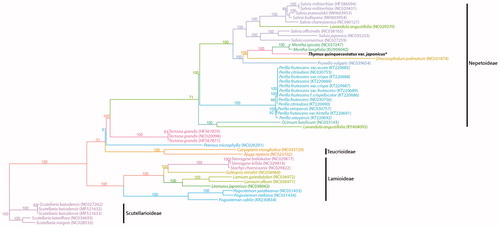Abstract
The complete chloroplast (cp) genome sequence of Thymus quinquecostatus var. japonicus, an endemic species to Ulleung Island of Korea and used as plant material for folk remedies, was firstly analyzed in this study. It showed a typical circular structure composed of 151,782 bp in length and comprised of a large single-copy region (82,903bp) and a small single-copy region (17,667 bp) which were separated by two inverted repeat regions (25,606 bp). From the phylogenetic analyses of related taxa using the complete chloroplast genome sequences, it was proved that T. quinquecostatus var. japonicus is sister to the member of genus Mentha within the subfamily Nepetoideae.
The family Lamiaceae Martynov, well-known as mint family, is a widespread cosmopolitan plant group. Although the recognition and the classification of this larger family has been debated (Wagstaff and Olmstead Citation1997), it is recently regarded the plant group composed of 12 subfamilies and including over 7000 species (Chase et al. Citation2016). Among them, the genus Thymus L. belongs to the monophyletic subfamily Nepetoideae (Dumortier) Luerssonand including 250–350 taxa distributed mainly in Europe, Northwest Africa, and Asia (Lee et al. Citation2011; Bartolucci et al. Citation2013). For the commercial uses and medicinal feature, lots of study have been conducted to prove the components and effects using the extract from the plants (Lee et al. Citation2011). In Korea, three native species have been reported and Thymus quinquecostatus var. japonicas H. Hara is an plant endemic to Ulleung Island of Korea. The complete chloroplast genome of the vascular plants has been accumulated speedily, but there was no information about it of the genus Thymus. This is the first report of the complete chloroplast genome sequence of the genus.
We collected the plant material from Anpyungjeon (37°29.12′N, 130°52.5959′E, alt. 432.9 M) of Ulleung Island and the voucher (Lee & Kim 2017U4) was deposited at the Herbarium of Kyungpook National University (KNU). Complete chloroplast genome of Thymus quinquecostatus var. japonicas (MN867687)was sequenced by HiSeq4000 of Illumina. Totally 47,627,276 paired-end reads (2 × 151bp) were obtained and 39,328,684 reads were used for the assemble to the reference sequence after trimming with the length range 50–151 bp. The assembled reads were de novo assembled using the Geneious assembler. Using the assembled contigs, we aligned and repeated the procedure to make a single contig. Complete chloroplast genome was annotated using Geneious10.2.6 (Kearse et al., Citation2012) with manual correction and tRNAScan-SE (Lowe and Eddy Citation1997) for tRNA gene. The average coverage of this chloroplast genome was 859.7. The phylogenetic tree was constructed with related Lamiaceae members based on the concatenated 78 coding genes using RAxML (Stamatakis, Citation2014).
The complete chloroplast genome of Thymus quinquecostatus var. japonicas had a typical circular structure with 151,782 bp in length and comprised a large single-copy region (LSC, 82,903bp), a small single-copy region (SSC, 17,667bp), and two inverted repeat regions (IR, 25,606bp). The GC content was 37.9%. It was composed of 135 genes and 87 coding genes, 8 rRNA genes, and 37 tRNA genes were identified. In the phylogenetic tree conducted based on the protein-coding genes sequences, the monophyly of the subfamily Nepetoideae was strongly supported and the sister relationship between Thymus quinquecostatus var. japonicus and the genus Mentha was clearly proved (). Both genera showed the close relationship to the genus Dracocephalum within the subfamily. Even though the phylogenetic relationship among the subfamilies of the family Lamiaceae still remains unclear, the generic relationship in the subfamily Nepetoideae and Lamioideae was suggested which have the amount of the data of complete chloroplast sequences.
Acknowledgements
The authors thank to Dr. W. Lee for his cooperation to collect the plant material for this study.
Disclosure statement
No potential conflict of interest was reported by the author(s).
Data availability statement
The data that support the findings of this study are openly available in NCBI database at https://www.ncbi.nlm.nih.gov/, reference number [MN867687] after this article is published.
Additional information
Funding
References
- Bartolucci F, Peruzzi L, Passalacqua N. 2013. Typification of names and taxonomic notes within the genus Thymus L. (Lamiaceae). Taxon. 62(6):1308–1314.
- Chase MW, Christenhusz MJM, Fay MF, Byng JW, Judd WS, Soltis DE, Mabberley DJ, Sennikov AN, Soltis PS, Stevens PF. 2016. An update of the angiosperm phylogeny group classification for the orders and families of flowering plants: APG IV. Bot J Lin Soc. 181:1–20.
- Kearse M, Moir R, Wilson A, Stone-Havas S, Cheung M, Sturrock S, Buxton S, Cooper A, Markowitz S, Duran C, et al. 2012. Geneious Basic: an integrated and extendable desktop software platform for the organization and analysis of sequence data. Bioinformatics. 28(12):1647–1649.
- Lee IC, Bae JS, Kim TO, Kwon J, Kim TH. 2011. Polyphenolic constituents from the aerial parts of Thymus quinquecostatus var. japonica collected on ulleung island. J Korean Soc Appl Biol Chem. 54(5):811–816.
- Lowe TM, Eddy SR. 1997. tRNAscan-SE: a program for improved detection of transfer RNA genes in genomic sequence. Nucl Acids Res. 25(5):955–964.
- Stamatakis A. 2014. RAxML version 8: a tool for phylogenetic analysis and post-analysis of large phylogenies. Bioinformatics. 30(9):1312–1313.
- Wagstaff SJ, Olmstead RG. 1997. Phylogeny of Lamiaceae and Verbenaceae inferred from rbcL sequences. Syst Bot. 22(1):165–179.

